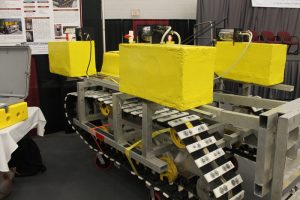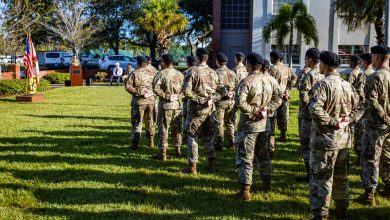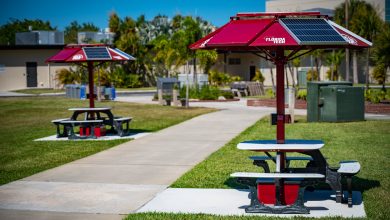Remotely Operated Underwater Vehicle Reduces Diver Risk
Four ocean engineering undergraduate students developed the fifth generation of a remotely operated sea crawler (ROSCo V) that is capable of undertaking seafloor missions deemed unsafe or too complex for divers.
ROSCo V eliminates the need for human participation in sea floor missions by going places and completing tasks that are hazardous to divers. The vehicle has a variety of real world applications that includes underwater archaeology and exploration, dredging and pipeline implementation. ROSCo V can also be customized to fit any mission that is desired, which makes its specific design so unique.
 “This remotely operated vehicle allows for the use of variable face-plate attachments to aid in a wide variety of practical underwater applications and has a lifting force of 200 pounds,” student Brooklynn Byford said.
“This remotely operated vehicle allows for the use of variable face-plate attachments to aid in a wide variety of practical underwater applications and has a lifting force of 200 pounds,” student Brooklynn Byford said.
ROSCo V also features a buoyancy control system that allows for vertical movement through the water. Its tank-like track system allows for easy translation along various types of ocean terrain and is fully operable at a depth of 100 feet.
“In today’s world, the need for underwater exploration and solutions to structure maintenance issues is at its highest,” Byford said. “However, we are often restricted by limitations of the human body.”
Byford chose the ROSCo project because the it involved a multidisciplinary design and required hands-on work in multiple areas of her major, like electrical and mechanical engineering, composites and software.
“Before this project, I couldn’t narrow down my interests to any specific areas but because my project involved every aspect of my major, I was able to experience each one and decide which ones I found the most interest in,” Byford said.
Going into this project, Byford had no idea the amount of personal skills and knowledge she would gain. She was introduced to a variety of situations that have prepared her for the real world. Byford learned how to effectively manage her time, delegate tasks and work alongside others to reach a common goal. She found positive communication was the key to her team’s success.
“Our project required working closely with manufacturing companies and this experience allowed us to gain a better understanding of the logistical preparation entailed with a project like ours,” Byford said.
Byford advises students not to give up.
“There were many times when my teammates and I were so close to a solution, only to find another obstacle arise,” Byford said. “So, always do that last trial, recheck your work, or do a run-through one more time!”
Byford believes student design and research allows students to open their minds to the endless possibilities available to them.
“These projects require students to be independent while also using their resources, Byford said. “They teach responsibility and require students to think analytically about their projects.”





